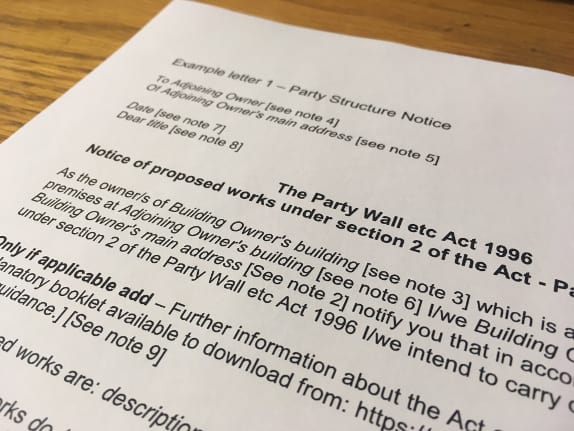
If you are planning to carry out alterations to your home (or your neighbour is planning modifications to their home) that will affect a shared wall or boundary, it’s likely that you will have heard of the Party Wall Act. Introduced in 1996, this piece of legislation is designed to protect the interests of both Building Owners and Adjoining Owners, ensuring that building work can be completed with minimal disruption to either household.
The Party Wall etc. Act 1996 is essentially a framework for the prevention and resolution of disputes surrounding party wall construction or alterations. It covers any new building work that is on or at the boundary of two properties, including shared walls or structures, and also applies to excavation that is near to and goes below the foundations of neighbouring buildings. Common projects to be affected are basement and loft conversions, chimney breast removal and building extensions or conservatories.
Serving Party Wall Notice
If a project is going to be affected by the Party Wall Act, a specific procedure will have to be followed, starting with the Building Owner serving a Party Wall Notice on any and all affected Adjoining Owners. Be aware that “owners” include:
· Freeholders
· Leaseholders with an interest exceeding a year
· Buyers that are under contract to purchase the freehold or leasehold
· Those that are entitled to rent from the property
This may mean that there is more than one party that will require a Party Wall Notice, and you should keep in mind that any of these parties may object to your plans.
Tips for getting your neighbours to consent
It’s a legal requirement to get formal consent from the Adjoining Owner before works can commence – meaning you can expect considerable delays (and escalating costs) if there are parts of the plans they’re not happy about and wish to negotiate with you, go through a specialist surveyor.
Providing you have a good relationship with your neighbour (or at least, not a bad one), getting them on board should be straightforward enough. For starters, knock on their door and have a friendly conversation about your plan while you’re in the early stages. This will generally set a good tone for the process, making them feel included and giving you the opportunity to iron out any potential issues as soon as possible. Listen to any concerns your neighbours may have and demonstrate that you’re willing to make some practical adjustments.
If you don’t get along with your neighbour(s), don’t worry – they can’t actually stop you from carrying out your project. However, if they do not provide written consent to your plans within 14 days of Notice being served, this will be considered a dispute and you will have to appoint separate surveyors, or agree on a joint surveyor, that will negotiate an agreement between you. This will be at the expense of the Building Owner and will result in particular terms being laid out in a Party Wall Award, which must be adhered to.
In either case, it’s good practice to serve Notice as early as possible (ideally a few months before work is due to start) so that your neighbours don’t feel rushed into making a decision.
How to respond to a Party Wall Notice

If you are an Adjoining Owner that has been served a Party Wall Notice, or have had a discussion with your neighbour and think you will be served one soon, there are three courses of action. Before choosing any of them, it’s highly recommended that you speak with a professional (such as a surveyor) to go through the possible problems that might arise and how you may be affected.
The first option is to provide written consent within fourteen days of receiving the Notice. Although this might seem like the neighbourly option, be aware that this will allow the Building Owner to proceed with their work without shouldering any responsibility for damage that might occur to your property as a result.
More commonly, Adjoining Owners decide to dissent to the Notice but agree to share the same surveyor as the Building Owner to negotiate a Party Wall Award. This typically means that a Schedule of Condition will be taken of both homes so that any damages can be appropriately attributed. A shared surveyor will still act independently and in the interests of both parties, even though their costs are covered by the Building Owner.
If you do not feel comfortable with the surveyor that has been appointed by the Building Owner, the third option is to dissent and appoint your own surveyor (again, at the expense of the Building Owner).
What happens after Notice has been served?
The Adjoining Owner has 14 days in which to provide consent. After this period, a follow-up notice will be sent, giving an additional ten days, in which the Adjoining Owner must decide whether to instruct their own surveyor or agree to use the same firm as their neighbour. If they do not, the Building Owner’s surveyor will appoint a third-party surveyor on their behalf and negotiations for the Party Wall Award will begin.
For more details about the Party Wall process, you can read the Government’s advice booklet here.
Are you looking to buy property in UK ? Hurghada , Scotland , Istanbul , Sahl Hasheesh , Dubai
Are you looking to rent property in UK ? London , Manchester , Reading , Leeds , Cardiff











Author
Dakota Murphey
Dakota Murphey is an independent writer specialising in property law.